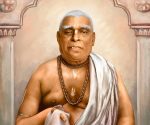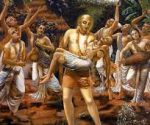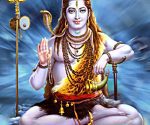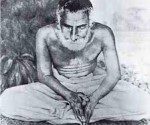The Contribution of Srila Bhaktivinoda Thakura
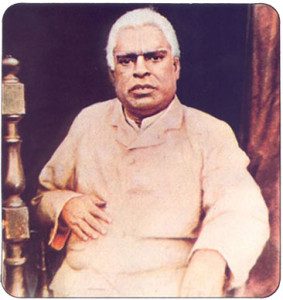 September 17, 2013 (VNN) Srimad Bhaktivedanta Narayana Gosvami Maharaja
September 17, 2013 (VNN) Srimad Bhaktivedanta Narayana Gosvami Maharaja
The glories of Srila Bhaktivinoda Thakura are so magnificant that even Lord Brahma, with his four mouths, cannot completely describe them. Srila Bhaktivinoda Thakura was a transcendental personality and we are not transcendental, so how then can we touch them? Only a transcendental person can expound on his glories.
We have heard from our gurudeva and other Vaisnavas, and we have also read in authentic books, that Srila Bhaktivinoda Thakura was given the title ‘Seventh Gosvami.’ From the time of the Six Gosvamis up to his time, no one else was ever designated as such. During his manifest stay in this world (1838-1914), learned persons and devotees saw his glorious activities and gave him this title. It was he who once again illuminated the true principles of Gaudiya Vaisnavism. If he had not appeared when he did, all the teachings of pure Gaudiya Vaisnavism would have been forever drowned in an ocean of oblivion.
That time was a dark period for Gaudiya Vaisnavaism. The sahajiyas used to give what they called siddha-pranali (the process, or system, that gives spiritual perfection), or siddha-deha, to anyone and everyone, without even knowing whether or not their so-called followers were actually devotees.
The followers neither knew any Gaudiya Vaisnava philosophy nor did they have any sadacara, (proper etiquette and behavior), yet they would take shelter of their sahajiya-babaji gurus who pretended to give them their spiritual forms made of eternity, unfathomed bliss, and unlimited knowledge .
They misunderstood Sri Caitanya Mahaprabhu’s teachings. According to their conception of siddha-deha, Gaudiya bhajana meant traveling to Vrndavana, living there, and having children with other’s wives. They considered that by doing this they had become gopis. “Come on, come on,” their guru would say to them. “I’m giving you siddha-deha and siddha-pranali.”
To whom did he pretend to give siddha-deha? Thinking, “I am this body,” his disciples were totally devoid of knowledge about Sri Caitanya Mahaprabhu’s teachings. Such persons did not know that they are eternally part and parcel and servants of Krsna. In reality, instead of being given gopi-bhava they were given ‘goopi’-bhava.
What are ‘goopis’? Goopis are lovers or beloveds of this world. They think that they should find a lady, live with her, and enjoy sex life. They think this bogus prema to be Sri Caitanya Mahaprabhu’s philosophy.
[Prakrta-sahajiyas are those who understand the aprakrta (spiritual) pastimes of the aprakrta Supreme Personality of Godhead to be prakrta (mundane) like the affairs of ordinary men and women, and who think that aprakrta-tattva (established spiritual truth) is attained by a material sadhana (malpractice in the name of spiritual practice). (from Parama-gurudeva’s bio, part 6)]
In the name of Gaudiya Vaisnavism, these sahajiyas would perform Hare Krsna kirtana, following the dead body during funeral processions, and then take a large payment from the deceased’s rich relatives. In their so-called kirtanas the word ‘Krsna’ did not clearly manifest; it was difficult for the audience to actually find the word “Krsna.” The chanters sang, “Hare Krsna-a-a-a-a-a-a,” in a fancy melody. Then the audience applauded, calling out, “O, very good, very good,” and paid them some rupees. Although those chanters drank wine and ate meat and fish, they still imagined themselves in the realm of proper behavior, and they were still called Vaisnavas by unintelligent people. Because of such disgraceful displays, learned and educated persons became ashamed and did not want to associate themselves with the words ‘Gaudiya Vaisnavism.’
Srila Bhaktivinoda Thakura was, in his time, the first person to preach the factual philosophy of Sri Caitanya Mahaprabhu to this learned society. By his preaching, people came to know about true transcendental love, prema-bhakti, and it is for this reason that he was given the title Seventh Gosvami.
Just as King Bhagiratha brought the Ganges River to the Earth, to India, Srila Bhaktivinoda Thakura brought the bhakti-gaìga (the flowing Ganges River of bhakti) to this world. Because of him, numerous people became inspired to follow pure Gaudiya Vaisnavism. If he had not appeared, we would not have joined this mission. If Srila Bhaktivedanta Svami Maharaja had not come to the West – if he had not gone to Srila Bhaktisiddhanta Sarasvati Thakura and if Srila Bhaktisiddhanta Sarasvati Thakura had not come from Srila Bhaktivinoda Thakura, what would have been your fate? Your good fortune is coming from Srila Bhaktivinoda Thakura, who preached the very pure doctrines of Sri Caitanya Mahaprabhu.
To Help Them
Due to lack of intelligence – to ignorance – these so-called babajis speak the way they do. In order to help them, Srila Bhaktivinoda Thakura clearly explained the entire process for achieving spiritual perfection in his final literary work, Jaiva-dharma. In that book he clearly elucidated the qualifications for receiving full spiritual enlightenmant, explaining under what circumstances the bona fide guru reveals siddha-deha to a qualified disciple; and previously, in his book Bhajana-rahasya, he clarified many deep siddhantas on the same subject. Those who actually want to enter the realm of bhakti may try to follow Bhajana-rahasya, Jaiva-dharma, and all his other books.
As mentioned earlier, Srila Bhaktivinoda Thakura wrote in Bhajana-rahasya that our bhakti begins by our trying to serve and realize the first verse of Sri Siksastakam: ceto-darpana-marjanam bhava-maha-davagni-nirvapanam, We then follow and practice the second verse: namnam akari bahudha nija-sarva-saktis. And then the third: trnad api sunicena taror iva sahisnuna. If we factually adopt the qualities delineated therein, we may enter the fourth: na dhanam na janam na sundarim. At that time we are detached from worldly desires and tastes. When we become still more pure, when we are always chanting and remembering Krsna without being disturbed by any obstacle, we can enter the fifth: ayi nanda-tanuja kiìkaram.
Entrance into this fifth verse is the beginning of siddha-deha, at which time we realize ourselves as eternal servants of Krsna in a specific relationship. All aspects of our eternal relationship are already in our atma, or soul, just as the potency of a fully grown tree is present in the seed of that tree. With water, air, and light the seed sprouts, and gradually leaves, branches, flowers, manjaris, and finally fruits also manifest. The entire tree or creeper is there in its seed, but only when air, water, and sunlight touch it do all its features sprout. Similarly, the full potency of our pure bhakti is present in our atma, but it manifests only by adopting the correct bhakti process. In this fifth verse, the jiva-svarupa is revealed.
The sixth verse of Sri Siksastakam states:
nayanam galad-asru-dharaya
vadanam gadgada-ruddhaya gira
pulakair nicitam vapuh kada
tava nama-grahane bhavisyati
[“O Prabhu! When will my eyes be filled with a stream of tears? When will my voice choke up? And when will the hairs of my body stand erect in ecstasy as I chant Your holy name.”]
When a devotee realizes his atma and understands that he is an eternal servant of Krsna, he has no worldly attachments. At this stage the svarupa-sakti, as hladini and samvit mercifully manifests in his heart. He begins to weep, and, while chanting the holy name of Krsna, he rolls on the earth and sings, “Agha-damana (O Krsna, killer of the Agha demon), Yasodanandana (O son of Yasoda), O, Nanda-sunoh (O, son of Nanda Maharaja), where are You?”
The devotee may sometimes get a glimpse of Krsna and immediately run towards Him. And then, when Krsna goes out of sight, that devotee rolls on the ground in separation. If one does not feel this type of separation, his constitutional form does not manifest. Those who artificially exhibit emotions of separation will go to hell, like the thousands of sahajiya babajis in Vrndavana and Radha-kunda who are simply illicitly giving birth to children and engaging in other malpractices.
One of the brothers of Srila Bhaktisiddhanta Sarasvati Thakura used to think that his father, Srila Bhaktivinoda Thakura, was his physical body. In fact, he thought of himself as the son of Kedarnatha Datta (Srila Bhaktivinoda Thakura’s civil name), not Srila Bhaktivinoda Thakura. But Srila Bhaktisiddhanta Sarasvati Thakura considered his father to be an associate of Sri Krsna, Srimati Radharani, and Sri Caitanya Mahaprabhu. He never considered him his material father, a person made of blood and flesh. Srila Bhaktisiddhanta Sarasvati Thakura actually followed the path of Srila Bhaktivinoda Thakura. Whatever his father spoke, he fully accepted and followed.
Our goal is siddha-deha, but what is siddha-deha? What is siddha-pranali? Who started it, in what year did it begin, and from where did it originate? Srila Sanatana Gosvami and Srila Rupa Gosvami are called Gosvamis, not babajis. No one has given them the title Rupa babaji, Sanatana babaji, or Srila Raghunatha dasa babaji. At the time of Srila Visvanatha Cakravarti Thakura, no one addressed him as Visvanatha Cakravarti babaji. During his time the process of giving someone this bogus version of gopi-bhava was not practiced. Who gave this siddha-pranali to them?
What is siddha-pranali? Again, siddha-pranali is Siksastakam – from the beginning verse, the first verse. He becomes detached from worldly attractions and chants and remembers Krsna twenty-four hours a day under the guidance of any very qualified Vaisnava.
tan-nama-rupa-caritadi-sukirtananu-
smrtyoh kramena rasana-manasi niyojya
tisthan vraje tad-anuragi jananugami
kalam nayed akhilam ity upadesa-saram
[Sri Upadesamrta 8]
[“The essence of all advice is that one should utilize one’s full time – twenty-four hours a day – in nicely chanting and remembering the Lord’s divine name, transcendental form, qualities and eternal pastimes, thereby gradually engaging one’s tongue and mind. In this way one should reside in Vraja [Goloka Vrndavana-dhama] and serve Krsna under the guidance of devotees. One should follow in the footsteps of the Lord’s beloved devotees, who are deeply attached to His devotional service.”]
This is real siddha-pranali, and Srila Raghunatha dasa Gosvami has explained this in his prayer called Manah-siksa. All the verses of his prayer are pranali – not artificial imaginings.
From where and from whom has this artificial siddha-deha come? There is no history. It is not in our culture, nor is it the teaching of Sri Caitanya Mahaprabhu. Real siddha-deha and siddha-pranali manifest when we follow the correct process – from guru-karana (taking complete shelter of guru), guru-bhajana (worshiping him), and guru-seva (serving him under his direction), and after that, bhajana-pranali. It comes by purely adopting the process of sravanam (hearing), kirtanam (chanting), visnoh-smaranam (remembering the Lord), pada-sevanam (serving the Lord’s lotus feet), arcanam (worshiping), vandanam (offering prayers), dasyam (becoming a servant), sakhyam (becoming a friend), atma-nivedanam. (surrendering everything). It comes by:
sadhu-sanga, nama-kirtana, bhagavata-sravana
mathura-vasa, sri-murtira sraddhaya sevana
[ Sri Caitanya-caritamrta (Madhya 22.128)]
[“In the association of devotees one should chant the holy name of the Lord, hear Srimad-Bhagavatam, reside in Mathura, and worship the Deity with faith and veneration.”]
By our following these processes, Sri Krsna and Srimati Radhika will mercifully give us our perfect form, that form which is fit to serve Them.
How Sri Narada Muni Received Siddha-Deha
Srimad-Bhagavatam states that Narada Muni received his mantra from Sanaka, Sanandana, Sanatana, and Sanat-kumara. Later, as soon as his mother died, he left for the dense forest. There he bathed in a river, sat down silently under the shade of a banyan tree, chanted his mantra, and meditated upon the Supersoul within his heart. After practicing this for many years, Lord Visnu momentarily manifested in his heart and then vanished.
As mentioned earlier, Narada wept bitterly in separation from Lord Visnu, and then a voice from the sky called to him, “Narada, I will not give you darsana again as long as you are in this material body. Continue chanting My name, remembering Me, and glorifying My pastimes all over the world. At the appropriate time, when death comes, you’ll put your feet on the head of death.”
Following Visnu’s instruction, Narada always chanted and remembered the Lord, and while playing on his vina he sang songs and poems glorifying the pastimes of Krsna. For example, he sang, “Radha-ramana haribol.” Bhaktivinoda Thakura wrote about many pastimes of Krsna and His devotees in his own poetries and songs. He wrote a song beginning, “Narada muni bajaya vina radhika ramana name – Narada Muni plays his vina while chanting the glories of Radha and Krsna.”
He also wrote,
yasomati-nandana, braja-baro-nagara,
gokula-ranjana kana
gopi-parana-dhana, madana-manohara,
kaliya-damana-vidhana
[“Lord Krsna is the beloved son of Mother Yasoda; the transcendental lover in the land of Vraja; the delight of Gokula; Kana (a nickname of Krsna); the wealth of the lives of the gopis. He steals the mind of even Cupid and punishes the Kaliya serpent.”]
After many years, death came to Narada. At that same moment his siddha-deha manifested, and in that siddha-deha he became so powerful that he could travel anywhere in the universe or beyond. Unlike Dhruva Maharaja, Narada did not require the help of an airplane to transport him to Vaikuntha.
We should try to know all of the processes taught by Srila Bhaktivinoda Thakura: sravana dasa (the stage of hearing), varana dasa (the stage of thirsting spiritual emotions), smarana dasa (the stage of remembrance, [*see endnote 1] at intervals, of the Lord and His intimate associates), bhavapana dasa (the stage of uninterrupted remembrance and ecstatic spiritual sentiments in bhava-bhakti or svarupa-siddhi), and finally prema-sampatti dasa (attaining the ultimate goal, love of Godhead). It is in sampatti dasa that one fully realizes his siddha-deha (this stage is also called vasthu-siddhi, the spiritual body receiving direct darsana of the Lord and His associates).
In sravana dasa, one hears the process for perfection from his bona fide guru from Vedic scriptures like Srimad-Bhagavatam, Sri Caitanya-caritamrta, Jaiva-dharma, and the entire philosophy of Srila Rupa Gosvami. In sravana dasa there are many things to learn, such as who you are and what is your name – not the name of your material body, but of your transcendental body.
The true guru knows this. A false guru does not know this, but by imagination he gives this type of information. The bona fide guru knows everything: your name, your relationship with Sri Krsna and Srimati-Radhika and the gopis, your place of residence – whether it is at Radha-kunda or Javaöa or Nandagaon or Varsana – the name of your father and mother, your service, and the nature of your beautiful form. He then reveals your particular service to Radha-Krsna conjugal, and your palya-dasi-bhava, your nature as a maidservant of Srimati Radhika.
As I mentioned earlier, there are eleven items in all.
Taste in the Name and Mercy to All
To teach this actual process was the main objective of Srila Bhaktivinoda Thakura, whose teachings can be summarized in two lines: Jiva-daya krsna-nama, sarva dharma sara. This is also the sum and substance of all the teachings of all the Vedas, Vedanta, Upanisads, Bhagavad-gita, the Puranas, Srutis, Smrtis, and Pancaratra.
In essence, there are two principles – jiva-daya and krsna-nama. The meaning of jiva-daya is ‘mercy to conditioned souls.’ Srila Bhaktivinoda Thakura has elaborately explained that the best daya, or mercy, is turning conditioned souls from their worldly moods to the mood of service to Krsna. It is worth more than opening hundreds of thousands of hospitals and universities, or donating hundreds of thousands of dollars in charity. Jiva-daya is the most special gift, and it is given by the realized soul.
harer nama harer nama harer namaiva kevalam
kalau nasty eva nasty eva nasty eva gatir anyatha
[Sri Caitanya-caritamrta (Adi 17.21)]
[“In this age of quarrel and hypocrisy, the only means of deliverance is the chanting of the holy name of the Lord. There is no other way. There is no other way. There is no other way.”]
Jiva-daya is attained only by chanting Krsna’s holy name. Krsna’s name is Krsna Himself, but we can chant suddha (pure) nama only in the association of the bona fide guru and bona fide Vaisnavas. Without this association we can neither chant the pure name nor engage in pure suddha-bhakti.
What is suddha-bhakti, pure devotion? Raganuga-bhakti is suddha-bhakti. [*see endnote 2]
We may think that vaidhi-bhakti is suddha-bhakti, but it is not, nor will it ever become so. Spontaneous devotion to Krsna is raganuga-bhakti, and when the practice of raganuga-bhakti fully matures, it is then called ragatmika-prema, or the love of the associated of Krsna in Vrndavana. When we yet have no ragatmika-prema, then cultivation of that pure ragatmika-bhakti with all of our senses is called raganuga, devotion performed in pursuance of the ragatmika bhaktas. Moreover, when our hearts accept the same mood that Srila Rupa Gosvami possesses in his heart – the mood of a palya-dasi of Srimati Radhika – it is called rupanuga-bhakti.
We conditioned souls are eligible to become palya-dasis, maidservants of Srimati Radhika. We cannot become like Lalita or Visakha, whose position as direct beloveds of Krsna is beyond our limit of attainment. We can follow only Srila Rupa Gosvami or Rupa-manjari, Rati-manjari, Lavanga-manjari, and all the other manjaris. The sahajiya babajis’ utterance of “Oh, you are Lalita. I am Lalita” is nothing but mayavada philosophy or monism, artificial imitation.
Srila Bhaktivinoda Thakura foretold that in the near future many hundreds of thousands of Western devotees with sikha and tulasi-mala will meet with Indian devotees, and they will all chant together, “Haribol, haribol,” “Gaura premanande, hari haribol,” and “Hare Krsna, Hare Krsna, Krsna Krsna, Hare Hare, Hare Rama, Hare Rama, Rama Rama, Hare Hare.” Thus, all over the world the pure mission of Sri Caitanya Mahaprabhu will spread. This idea was started by Srila Bhaktivinoda Öhakura. He is the root of all our preaching, and therefore we are truly indebted to him.
[* Endnote 1: Because smarana is predominant in raganuga-bhakti, some persons, who still have anarthas and in whose hearts genuine attachment to Krsna has not yet appeared, make a deceitful display of solitary bhajana, and considering themselves raganuga devotees, they practise what they call asta-kaliya-lila-smarana. However, Bhakti-rasamrta-sindhu (1.2.101) quotes from the agama-sastras as follows:
sruti-smrti-puranadi-
pancaratra-vidhim vina
aikantiki harer bhaktir
utpatayaiva kalpate
“If a person violates the regulations mentioned in the Sruti, Smrti, Puranas and the Narada-pancaratra, great misgivings (anarthas) are produced, even though he may be engaged in one-pointed devotion to Hari.”]
[Endnote 2, from Prabhupada (lecture in Vrndavana, Nov.12, 1972): The more you are engaged in devotional service, the more your senses become pure or uncovered. And when it is completely uncovered, without any designation, then you are capable to serve Krsna. This is apprenticeship. Vaidhi-bhakti, that is apprenticeship. Real bhakti, para-bhakti, that is raganuga-bhakti.
“The original inhabitants of Vrndavana are attached to Krsna spontaneously in devotional service. Nothing can compare to such spontaneous devotional service, which is called ragatmika bhakti. When a devotee follows in the footsteps of the devotees of Vrndavana, his devotional service is called raganuga bhakti. (Caitanya-caritamrta Madhya-lila, 22.149)]




